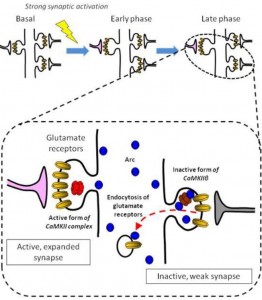The law of the synapses: punishing the weak to maintain strong synapses strong A novel molecular mechanism for long-lasting synaptic modulation that underlies learning and memory

Our brain possesses a huge capacity to store knowledge and to memorize distinct events throughout our life span. Such mnemonic ability is thought to be accounted for, in part, by long-term synaptic plasticity, a cellular mechanism to tune synaptic transmission efficacy between neurons and maintain this change over a long period of time. Several lines of evidence have shown that activity-dependent gene expression in the brain is crucial for long-term synaptic plasticity, but it was unknown how protein products derived from such gene expression contribute to changing neuronal synaptic efficiency. An even larger mystery was to understand how newly-expressed gene products selectively target the very synapses that needed to be modulated.

A dynamic CaMKIIβ-Arc interaction for glutamate receptor regulation © Haruhiko Bito
Rather than targeting strong synapses, up-regulated Arc targets weak synapses, and contributes to facilitating removal of glutamate receptors from the inactive postsynaptic membranes. The β isoform of CaMKII (CaMKIIβ) in the inactive synapse critically mediates such an “inverse” synaptic tagging process.
Associate Professor Haruhiko Bito and Dr. Hiroyuki Okuno at the Department of Neurochemistry, Graduate School of Medicine in the University of Tokyo, together with their colleagues and collaborators, tackled these questions and found a novel mechanism for regulating synaptic efficiency specifically in weak synapses. They focused on the activity-regulated gene product Arc and investigated Arc’s dynamics in the synapse. Contrary to previous views, they found that Arc protein was targeted to inactive, weak synapses, rather than to active, strong synapses. Furthermore, this privileged accumulation of Arc in weak synapses was negatively correlated with the expression of glutamate receptors at these synapses. Because the number of glutamate receptors directly determines the efficacy of synaptic connections between neurons in the brain, these results demonstrate that one critical role of Arc may be to keep weak synapses weak, while allowing strong, essential synapses to remain strong and capable of memory storage. The research group also showed that the selectivity of Arc targeting to the weak synapses was caused by a dynamic physical interaction of Arc with the β subunit of Ca2+/Calmodulin kinase II (CaMKIIβ), another key molecular player implicated in synaptic plasticity and memory formation.
This finding provides new mechanistic insights on how the contrast between strong and weak synapses may be maintained during long-term synaptic plasticity, and opens the door to a better understanding of the molecular basis of biochemical memory at individual synapses, and ultimately, of learning and memory.
Press release (Japanese)
Paper
Hiroyuki Okuno, Kaori Akashi, Yuichiro Ishii, Nan Yagishita-Kyo, Kanzo Suzuki, Mio Nonaka, Takashi Kawashima, Hajime Fujii, Sayaka Takemoto-Kimura, Manabu Abe, Rie Natsume, Shoaib Chowdhury, Kenji Sakimura, Paul F. Worley, and Haruhiko Bito,
“Inverse synaptic tagging of inactive synapses via dynamic interaction of Arc/Arg3.1 with CaMKIIβ”,
Cell, May 11, 2012, print issue. doi: 10.1016/j.cell.2012.02.062.
Article link






